2013 VOLKSWAGEN TOUAREG rear window
[x] Cancel search: rear windowPage 121 of 440

resume until the windshield wipers are activated. This is to keep the wiper from working when the
window is dry. By switching rear window intermittent wiping off and then back on, you can override this
feature and activate the rear window wiper immediately.
The intermittent wiping for the front windshield depends on the driving speed. The higher the
speed, the faster the wipers move.
If the wiper blades freeze to the windshield, loosen them carefully. Volkswagen recommends
using a deicing spray.
f the front wipers are on, the rear wiper is switched on automatically when backing up.
Windshield wiper functions
�
Page 132 of 440
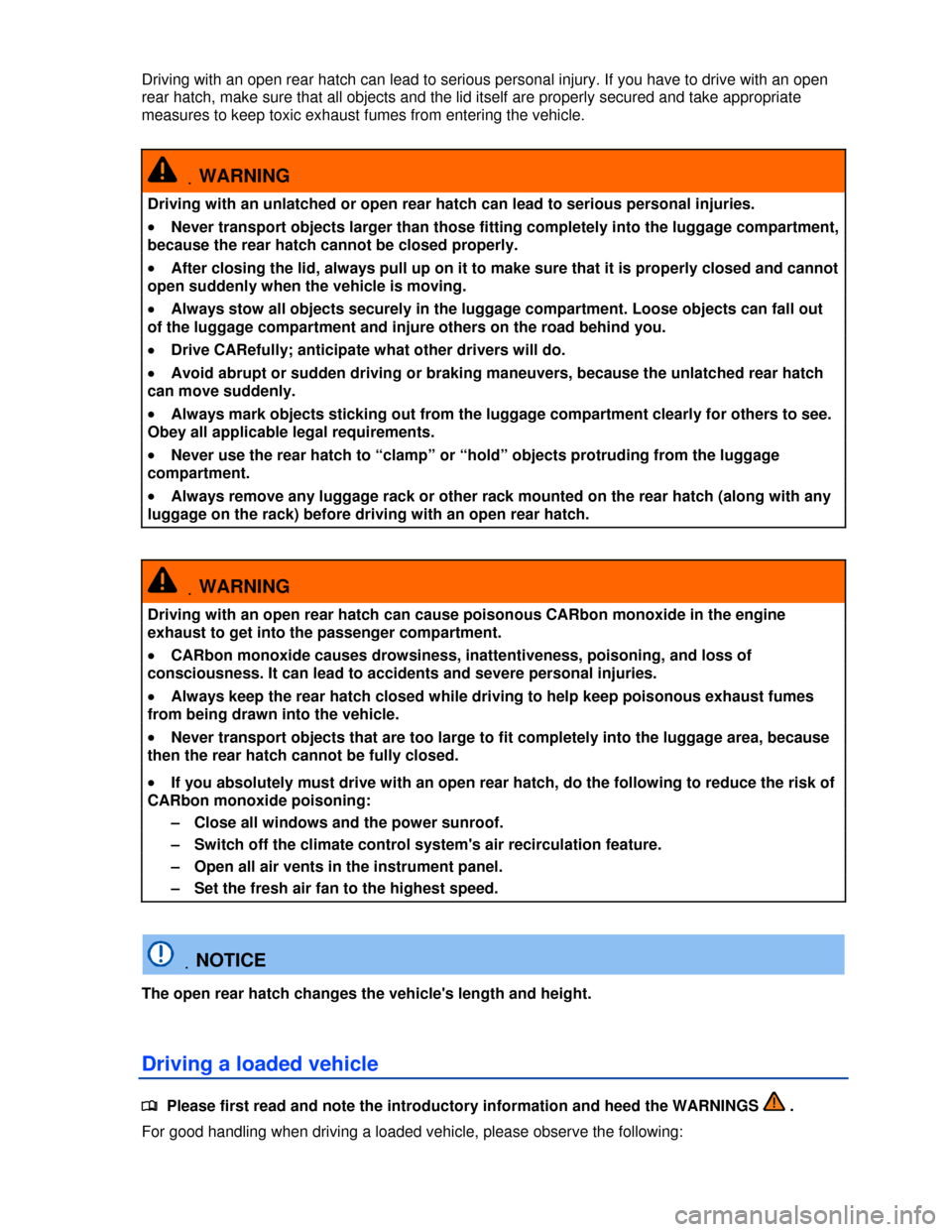
Driving with an open rear hatch can lead to serious personal injury. If you have to drive with an open
rear hatch, make sure that all objects and the lid itself are properly secured and take appropriate
measures to keep toxic exhaust fumes from entering the vehicle.
.WARNING
Driving with an unlatched or open rear hatch can lead to serious personal injuries.
�x Never transport objects larger than those fitting completely into the luggage compartment,
because the rear hatch cannot be closed properly.
�x After closing the lid, always pull up on it to make sure that it is properly closed and cannot
open suddenly when the vehicle is moving.
�x Always stow all objects securely in the luggage compartment. Loose objects can fall out
of the luggage compartment and injure others on the road behind you.
�x Drive CARefully; anticipate what other drivers will do.
�x Avoid abrupt or sudden driving or braking maneuvers, because the unlatched rear hatch
can move suddenly.
�x Always mark objects sticking out from the luggage compartment clearly for others to see.
Obey all applicable legal requirements.
�x Never use the rear hatch to “clamp” or “hold” objects protruding from the luggage
compartment.
�x Always remove any luggage rack or other rack mounted on the rear hatch (along with any
luggage on the rack) before driving with an open rear hatch.
.WARNING
Driving with an open rear hatch can cause poisonous CARbon monoxide in the engine
exhaust to get into the passenger compartment.
�x CARbon monoxide causes drowsiness, inattentiveness, poisoning, and loss of
consciousness. It can lead to accidents and severe personal injuries.
�x Always keep the rear hatch closed while driving to help keep poisonous exhaust fumes
from being drawn into the vehicle.
�x Never transport objects that are too large to fit completely into the luggage area, because
then the rear hatch cannot be fully closed.
�x If you absolutely must drive with an open rear hatch, do the following to reduce the risk of
CARbon monoxide poisoning:
– Close all windows and the power sunroof.
– Switch off the climate control system's air recirculation feature.
– Open all air vents in the instrument panel.
– Set the fresh air fan to the highest speed.
.NOTICE
The open rear hatch changes the vehicle's length and height.
Driving a loaded vehicle
�
Page 136 of 440
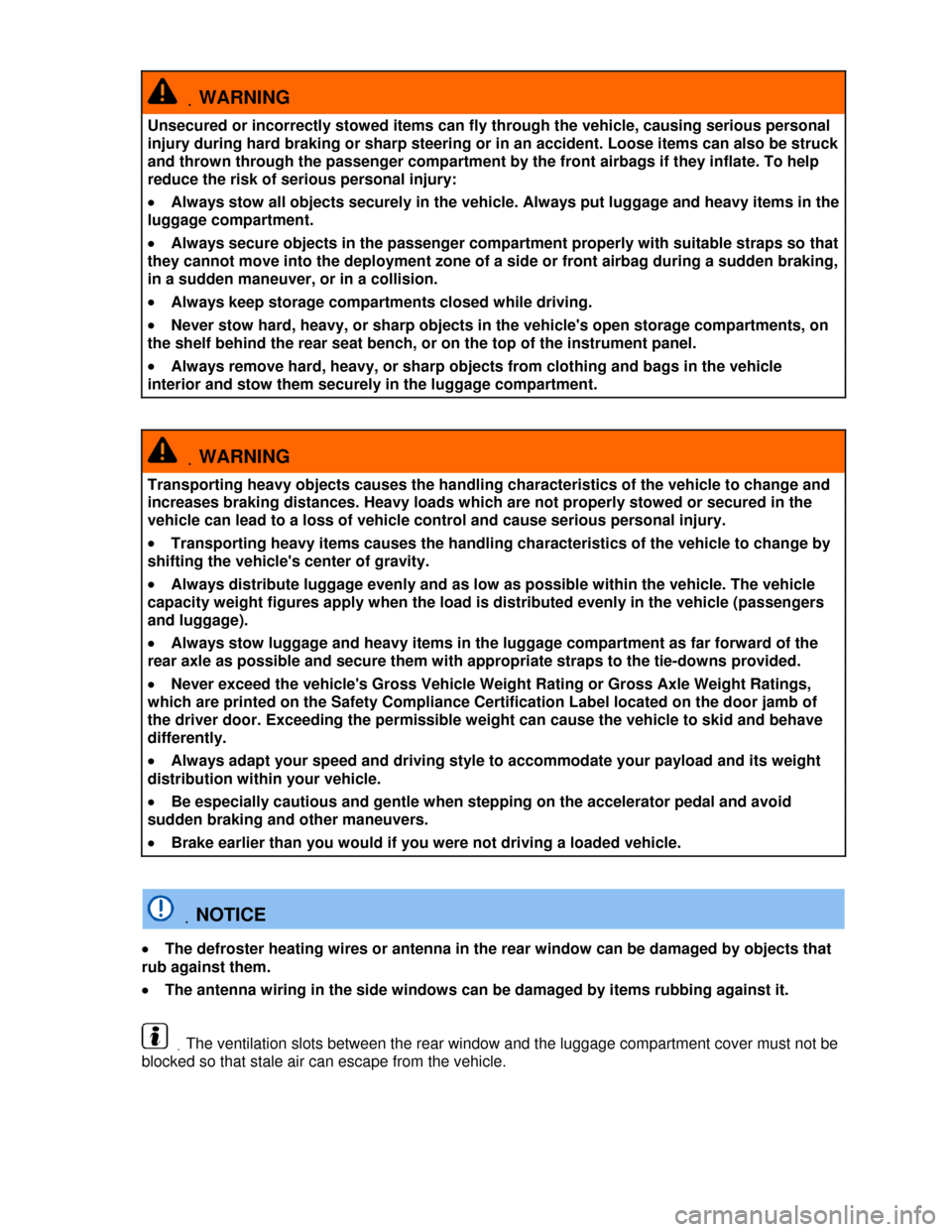
.WARNING
Unsecured or incorrectly stowed items can fly through the vehicle, causing serious personal
injury during hard braking or sharp steering or in an accident. Loose items can also be struck
and thrown through the passenger compartment by the front airbags if they inflate. To help
reduce the risk of serious personal injury:
�x Always stow all objects securely in the vehicle. Always put luggage and heavy items in the
luggage compartment.
�x Always secure objects in the passenger compartment properly with suitable straps so that
they cannot move into the deployment zone of a side or front airbag during a sudden braking,
in a sudden maneuver, or in a collision.
�x Always keep storage compartments closed while driving.
�x Never stow hard, heavy, or sharp objects in the vehicle's open storage compartments, on
the shelf behind the rear seat bench, or on the top of the instrument panel.
�x Always remove hard, heavy, or sharp objects from clothing and bags in the vehicle
interior and stow them securely in the luggage compartment.
.WARNING
Transporting heavy objects causes the handling characteristics of the vehicle to change and
increases braking distances. Heavy loads which are not properly stowed or secured in the
vehicle can lead to a loss of vehicle control and cause serious personal injury.
�x Transporting heavy items causes the handling characteristics of the vehicle to change by
shifting the vehicle's center of gravity.
�x Always distribute luggage evenly and as low as possible within the vehicle. The vehicle
capacity weight figures apply when the load is distributed evenly in the vehicle (passengers
and luggage).
�x Always stow luggage and heavy items in the luggage compartment as far forward of the
rear axle as possible and secure them with appropriate straps to the tie-downs provided.
�x Never exceed the vehicle's Gross Vehicle Weight Rating or Gross Axle Weight Ratings,
which are printed on the Safety Compliance Certification Label located on the door jamb of
the driver door. Exceeding the permissible weight can cause the vehicle to skid and behave
differently.
�x Always adapt your speed and driving style to accommodate your payload and its weight
distribution within your vehicle.
�x Be especially cautious and gentle when stepping on the accelerator pedal and avoid
sudden braking and other maneuvers.
�x Brake earlier than you would if you were not driving a loaded vehicle.
.NOTICE
�x The defroster heating wires or antenna in the rear window can be damaged by objects that
rub against them.
�x The antenna wiring in the side windows can be damaged by items rubbing against it.
.The ventilation slots between the rear window and the luggage compartment cover must not be
blocked so that stale air can escape from the vehicle.
Page 140 of 440
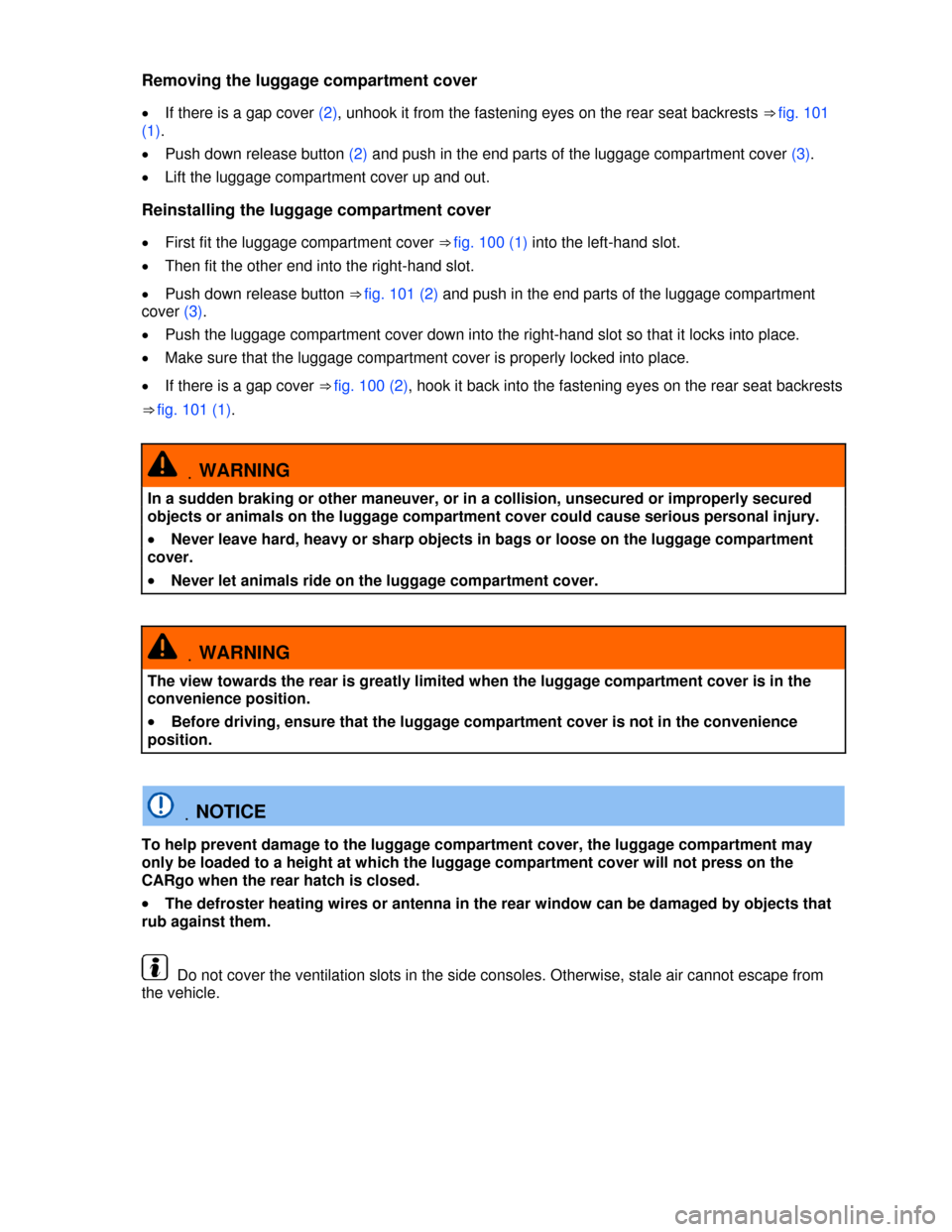
Removing the luggage compartment cover
�x If there is a gap cover (2), unhook it from the fastening eyes on the rear seat backrests ⇒ fig. 101
(1).
�x Push down release button (2) and push in the end parts of the luggage compartment cover (3).
�x Lift the luggage compartment cover up and out.
Reinstalling the luggage compartment cover
�x First fit the luggage compartment cover ⇒ fig. 100 (1) into the left-hand slot.
�x Then fit the other end into the right-hand slot.
�x Push down release button ⇒ fig. 101 (2) and push in the end parts of the luggage compartment
cover (3).
�x Push the luggage compartment cover down into the right-hand slot so that it locks into place.
�x Make sure that the luggage compartment cover is properly locked into place.
�x If there is a gap cover ⇒ fig. 100 (2), hook it back into the fastening eyes on the rear seat backrests
⇒ fig. 101 (1).
.WARNING
In a sudden braking or other maneuver, or in a collision, unsecured or improperly secured
objects or animals on the luggage compartment cover could cause serious personal injury.
�x Never leave hard, heavy or sharp objects in bags or loose on the luggage compartment
cover.
�x Never let animals ride on the luggage compartment cover.
.WARNING
The view towards the rear is greatly limited when the luggage compartment cover is in the
convenience position.
�x Before driving, ensure that the luggage compartment cover is not in the convenience
position.
.NOTICE
To help prevent damage to the luggage compartment cover, the luggage compartment may
only be loaded to a height at which the luggage compartment cover will not press on the
CARgo when the rear hatch is closed.
�x The defroster heating wires or antenna in the rear window can be damaged by objects that
rub against them.
Do not cover the ventilation slots in the side consoles. Otherwise, stale air cannot escape from
the vehicle.
Page 160 of 440
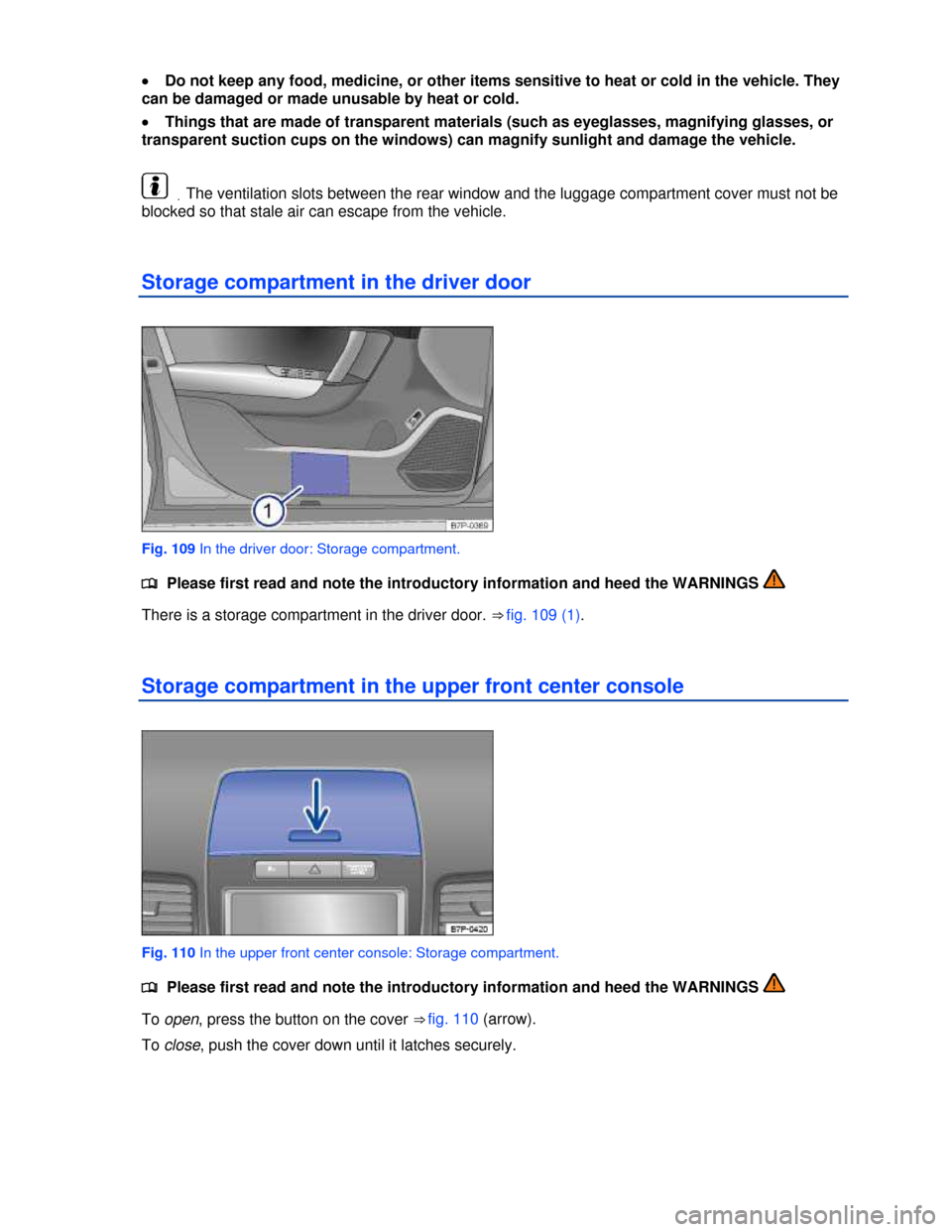
�x Do not keep any food, medicine, or other items sensitive to heat or cold in the vehicle. They
can be damaged or made unusable by heat or cold.
�x Things that are made of transparent materials (such as eyeglasses, magnifying glasses, or
transparent suction cups on the windows) can magnify sunlight and damage the vehicle.
.The ventilation slots between the rear window and the luggage compartment cover must not be
blocked so that stale air can escape from the vehicle.
Storage compartment in the driver door
Fig. 109 In the driver door: Storage compartment.
�
Page 339 of 440
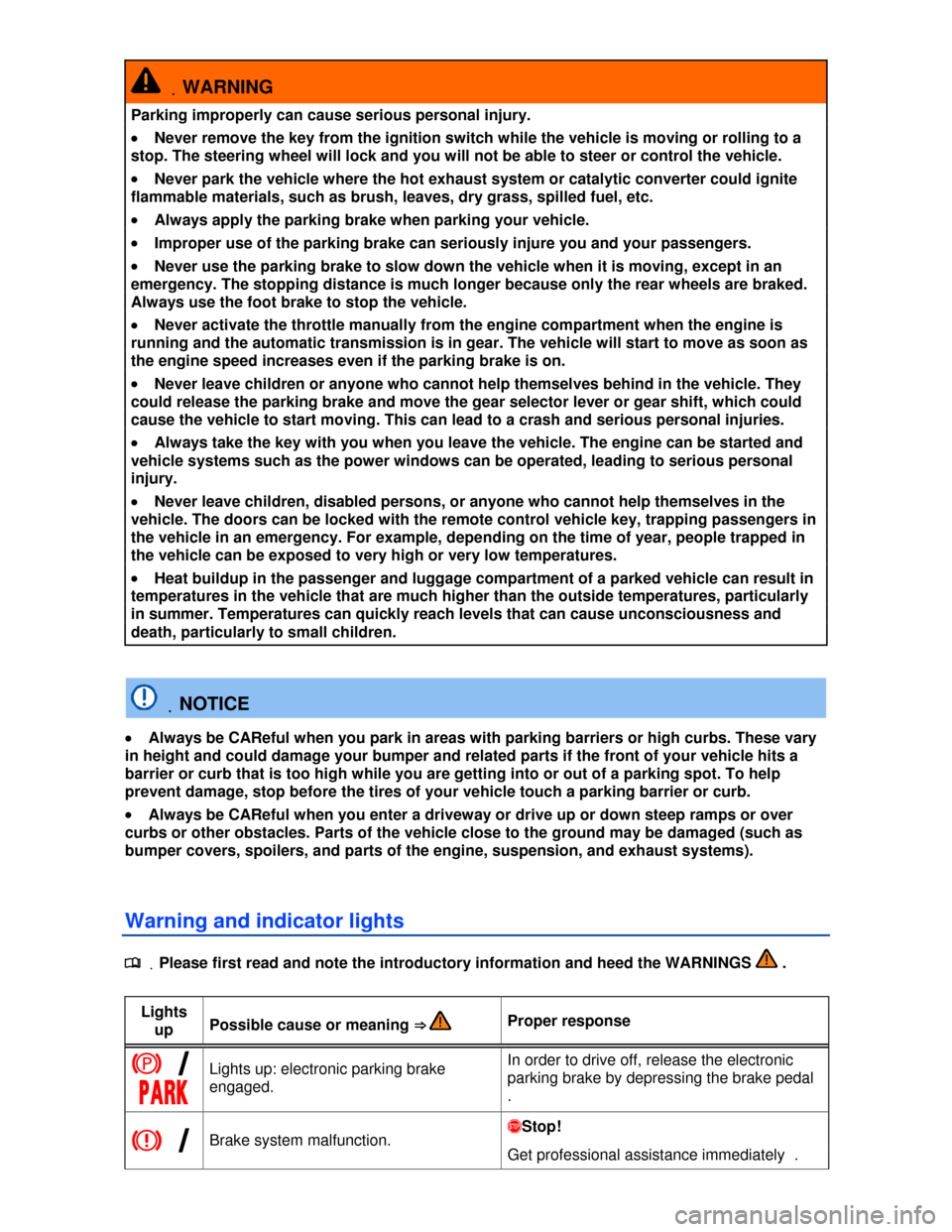
.WARNING
Parking improperly can cause serious personal injury.
�x Never remove the key from the ignition switch while the vehicle is moving or rolling to a
stop. The steering wheel will lock and you will not be able to steer or control the vehicle.
�x Never park the vehicle where the hot exhaust system or catalytic converter could ignite
flammable materials, such as brush, leaves, dry grass, spilled fuel, etc.
�x Always apply the parking brake when parking your vehicle.
�x Improper use of the parking brake can seriously injure you and your passengers.
�x Never use the parking brake to slow down the vehicle when it is moving, except in an
emergency. The stopping distance is much longer because only the rear wheels are braked.
Always use the foot brake to stop the vehicle.
�x Never activate the throttle manually from the engine compartment when the engine is
running and the automatic transmission is in gear. The vehicle will start to move as soon as
the engine speed increases even if the parking brake is on.
�x Never leave children or anyone who cannot help themselves behind in the vehicle. They
could release the parking brake and move the gear selector lever or gear shift, which could
cause the vehicle to start moving. This can lead to a crash and serious personal injuries.
�x Always take the key with you when you leave the vehicle. The engine can be started and
vehicle systems such as the power windows can be operated, leading to serious personal
injury.
�x Never leave children, disabled persons, or anyone who cannot help themselves in the
vehicle. The doors can be locked with the remote control vehicle key, trapping passengers in
the vehicle in an emergency. For example, depending on the time of year, people trapped in
the vehicle can be exposed to very high or very low temperatures.
�x Heat buildup in the passenger and luggage compartment of a parked vehicle can result in
temperatures in the vehicle that are much higher than the outside temperatures, particularly
in summer. Temperatures can quickly reach levels that can cause unconsciousness and
death, particularly to small children.
.NOTICE
�x Always be CAReful when you park in areas with parking barriers or high curbs. These vary
in height and could damage your bumper and related parts if the front of your vehicle hits a
barrier or curb that is too high while you are getting into or out of a parking spot. To help
prevent damage, stop before the tires of your vehicle touch a parking barrier or curb.
�x Always be CAReful when you enter a driveway or drive up or down steep ramps or over
curbs or other obstacles. Parts of the vehicle close to the ground may be damaged (such as
bumper covers, spoilers, and parts of the engine, suspension, and exhaust systems).
Warning and indicator lights
.�
Page 352 of 440
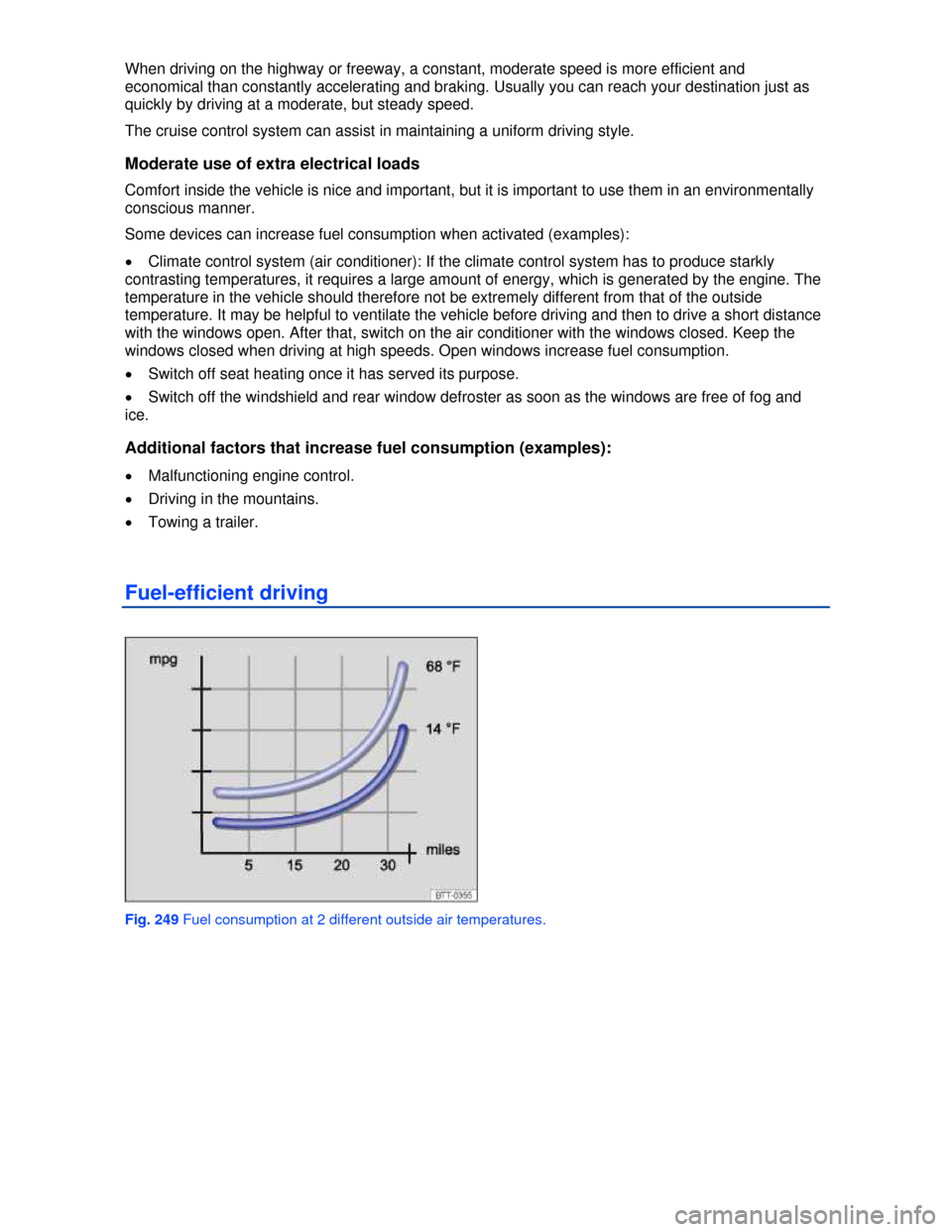
When driving on the highway or freeway, a constant, moderate speed is more efficient and
economical than constantly accelerating and braking. Usually you can reach your destination just as
quickly by driving at a moderate, but steady speed.
The cruise control system can assist in maintaining a uniform driving style.
Moderate use of extra electrical loads
Comfort inside the vehicle is nice and important, but it is important to use them in an environmentally
conscious manner.
Some devices can increase fuel consumption when activated (examples):
�x Climate control system (air conditioner): If the climate control system has to produce starkly
contrasting temperatures, it requires a large amount of energy, which is generated by the engine. The
temperature in the vehicle should therefore not be extremely different from that of the outside
temperature. It may be helpful to ventilate the vehicle before driving and then to drive a short distance
with the windows open. After that, switch on the air conditioner with the windows closed. Keep the
windows closed when driving at high speeds. Open windows increase fuel consumption.
�x Switch off seat heating once it has served its purpose.
�x Switch off the windshield and rear window defroster as soon as the windows are free of fog and
ice.
Additional factors that increase fuel consumption (examples):
�x Malfunctioning engine control.
�x Driving in the mountains.
�x Towing a trailer.
Fuel-efficient driving
Fig. 249 Fuel consumption at 2 different outside air temperatures.
Page 363 of 440

Driving
situations Requirements and conditions Vehicle behavior
– CAReful use of E-MODE button
⇒ fig. 251.
The high-voltage battery discharges quickly
with the E-MODE button switched on. This
can increase fuel consumption since driving
in electric mode is preferred in this case,
even though the combustion engine would
be more efficient.
Driving on
country roads
and highways.
– Conscious easing off of the
accelerator, to enable longer sailing
distance.
By easing off the accelerator, the
combustion engine is automatically
switched off and de-clutched. The vehicle
glides without engine power.
- Reducing speed by easing off the
accelerator early and not by
braking.
Sailing possible. Reduction of speed this
way is more fuel-efficient than through
braking.
- Avoid speeds of over about 160
km/h (99 mph).
Efficient sailing is possible with a speed of
about 160 km/h (99 mph) .
- CAReful selection of gear (S).
Sporty driving style with activated sport
programme increases fuel consumption.
Efficient sailing in sport programme with
combustion engine automatically switched
off is possible with a speed of about 70
km/h (43 mph).
Driving in cold
months.
- Do not warm up the combustion
engine by running it with the
vehicle stationary.
The temperature of the combustion engine
increases very slowly, but fuel consumption
increases considerably.
– CAReful use of heating for
windshield and the rear window,
outside mirror, seat and steering
wheel.
This prevents energy from being lost and
saves energy for the electric motor.
- Never leave the vehicle in a
garage over night.
This prevents the high-voltage battery and
the vehicle interior from cooling down too
much. The optimal temperature of the high-
voltage battery is reached quicker at the
beginning of the journey and the
combustion engine can be switched off
quicker when the vehicle interior is
sufficiently heated.